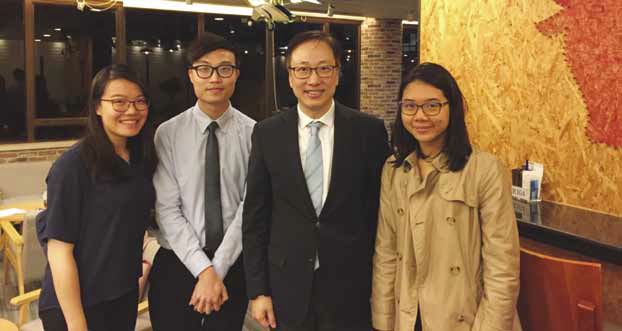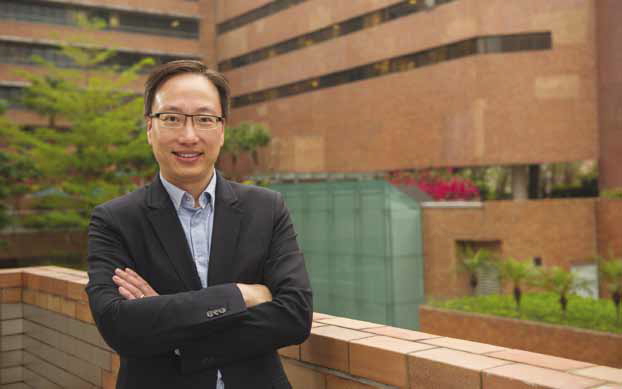© Hong Kong Academy of Medicine. CC BY-NC-ND 4.0
HEALTHCARE FOR SOCIETY
A pioneer in comprehensive rehabilitation: an interview
with Professor Chetwyn Chan
Michelle Tsui1; Marco Cheung2;
Chrystal Chan3
1 Year 3 (MB ChB), The Chinese
University of Hong Kong
2 Year 4 (MB BS), The University of Hong
Kong
3 Year 5 (MB ChB), The Chinese
University of Hong Kong
Professor Chetwyn Chan is a pioneer in his
field—one of the first to integrate academia with the community. Driven by
his strong belief that academia should pivot on the wider community, his
research efforts revamp the traditional concept of rehabilitation, firmly
establishing rehabilitative community services as an integral component of
modern healthcare.
Background and mission
A distinguished figure in the community, Prof Chan
serves diversified leadership roles in both administration and academia.
He is presently the Associate Vice President (Learning and Teaching),
Chair Professor of Rehabilitation Sciences, and Director of the University
Research Facility in Behavioral and Systems Neuroscience at The Hong Kong
Polytechnic University (PolyU). Outside of his official duties, he is
perhaps more well-recognised within the community as the Vice-Chairman of
the Executive Committee of The Hong Kong Society for Rehabilitation
(HKSR).
“I don’t believe academia is limited to only
research,” Professor Chan asserts. “Academia must not neglect social
needs.” It appears that few university graduates actively participate in
Hong Kong society, and he considers this a pitfall of the tertiary
education system. Unwilling to fall into this trap, he takes a further
step, using PolyU as a cradle for knowledge transfer.
After 3 years of clinical practice as an
occupational therapist, Professor Chan pursued a PhD in Educational
Psychology. He then became a scholar and researcher at PolyU and invested
his efforts in psychology and rehabilitation sciences. One of his main
research areas is post-stroke rehabilitation; an interest driven by a
vision of creating a paradigm shift in the community of stroke patients:
from engaging in activities of daily living to autonomous and independent
living.
“Things don’t happen easily with a mere desire to
take an extra step”, Professor Chan concedes, “it is important to choose
to do something that society truly needs and is willing to receive.” His
interest in helping disabled individuals coincided with an unmet gap
between post-stroke patients being discharged from hospital and their
leading a meaningful and productive life. Rehabilitation services were
often delayed, offered long after discharge from hospital, and the
services themselves were limited to the bare essentials. Aside from the
institutional shortcoming, there was a lack of patient awareness.
Post-stroke patients seemed to be led to believe that the basic services
provided by the Hospital Authority were adequate, and they were unaware of
needs- and community-based rehabilitation services that are crucial to
attain the goal of independent living. For instance, vocational
rehabilitation is pivotal in enabling young post-stroke patients to regain
a worker role in the family. Activity and participation have become the
cornerstones of the contemporary rehabilitation recommended by the
International Classification of Functioning, Disability and Health (ICF);
however, the Hospital Authority and post-stroke patients appeared
unmotivated to fund or purchase such services. There was a profound need
to develop rehabilitation services in conjunction with official healthcare
services.
Community-based post-stroke rehabilitation project
The field of rehabilitation has evolved greatly
over the past 30 years. In the past, it was little more than an
afterthought. In an ageing population and with younger onset of some
chronic illnesses, rehabilitation has developed into an integral part of
the patient healthcare journey.
Current stroke rehabilitation services provided at
the Hospital Authority focus on conventional skills training, helping
patients regain their ability to perform activities of daily living
through repeated practice. However, when patients are exposed to a
different scenario in the community, it is difficult for them to turn
their training into actual coping skills. To tackle this challenge,
Professor Chan, with his doctoral students, constructed the first
self-regulated learning protocol. The value of this protocol in helping
post-stroke patients to regain lost daily activity skills has been
validated in a series of randomised controlled trials. This day-to-day
intervention protocol consists of a three-stage training programme based
on cognitive neuroscience knowledge-task chunking, self-referenced
appraisal, and mental rehearsal. Self-regulated learning allows patients
to be more aware of their strengths (abilities) and weaknesses
(disabilities), so they can address new scenarios through integration and
synergy of skills they have learned or regained. This, as noted by
Professor Chan, is a good demonstration of pushing the limit of the
patients’ frontal cortex to produce the executive functions necessary for
achieving independent living in the community.
Using his knowledge of self-regulated learning and
the ICF model, Professor Chan established comprehensive rehabilitation
services for post-stroke patients in the HKSR. Professor Chan found that
this was as a great platform to bridge the divisions between academia and
community, as well as his interests to find solutions for addressing
patients’ needs in the community. The HKSR wholeheartedly embraces the
mission of providing community-based rehabilitative services for patients
with chronic diseases. Patients who have suffered from stroke are one of
the core groups benefitting from its services. The new service focuses on
the activity and participation needs of post-stroke patients and, in
particular, their return to work and community living. With this service
and the self-regulated learning strategy, post-stroke patients benefit
from a greater capability to work and live independently, as well as
contribute (rather than be a burden) to the well-being of their families
and communities.
By taking many carefully considered extra steps,
Professor Chan is transforming the post-stroke rehabilitation services
that were once an afterthought into a full-fledged framework with holistic
care. However, patient awareness of the new services is still lacking, and
rehabilitation services remain disconnected from hospitals. Professor Chan
continues to work hard, hoping to generate sufficient evidence and impact
with the new services, so that the government will adopt the new service
model into the health system. Professor Chan hopes, one day, to see
hospital- and community-based rehabilitation services in parallel, as a
cohesive whole.

Figure 2. Prof Chetwyn Chan (third from left) met student reporters (from left: Michelle, Marco and Chrystal) at The Hong Kong Polytechnic University


